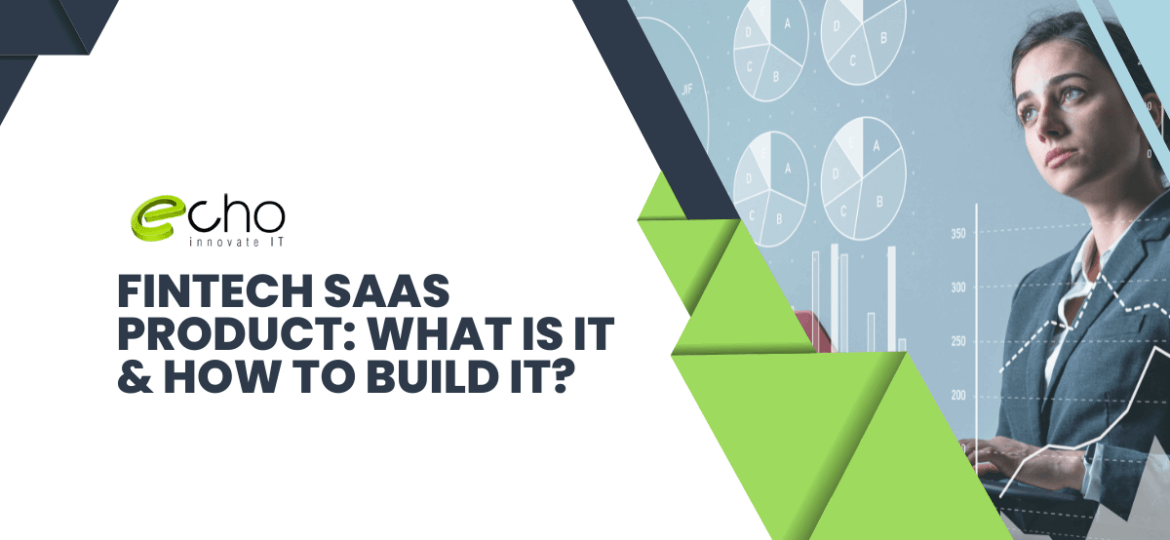Quick Summary
In the ever-changing financial technology (fintech) world, Software-as-a-Service (SaaS) goods have become very popular. Using the advantages of cloud-based fintech SaaS Applications, firms may use Fintech SaaS products to provide cutting-edge financial services to a scalable clientele. This article delves into the definition of financial technology software as a service product and lays out the essential steps to build your fintech solution software.
Technology has changed many fields, including financial services. The word “fintech,” coined due to the merging of the financial and technology industries, describes the digitization and use of technology in the financial industry. “Fintech” describes a broad category of technological advancements in the financial sector. Because of these developments, consumers all around the globe now have easier access to and more efficient usage of financial services.
What “fintech” is and how Fintech SaaS products are changing the financial sector and the market. We will examine the data demonstrating its meteoric rise and shed light on the major features and developments that characterize the fintech sphere.
What is Fintech?
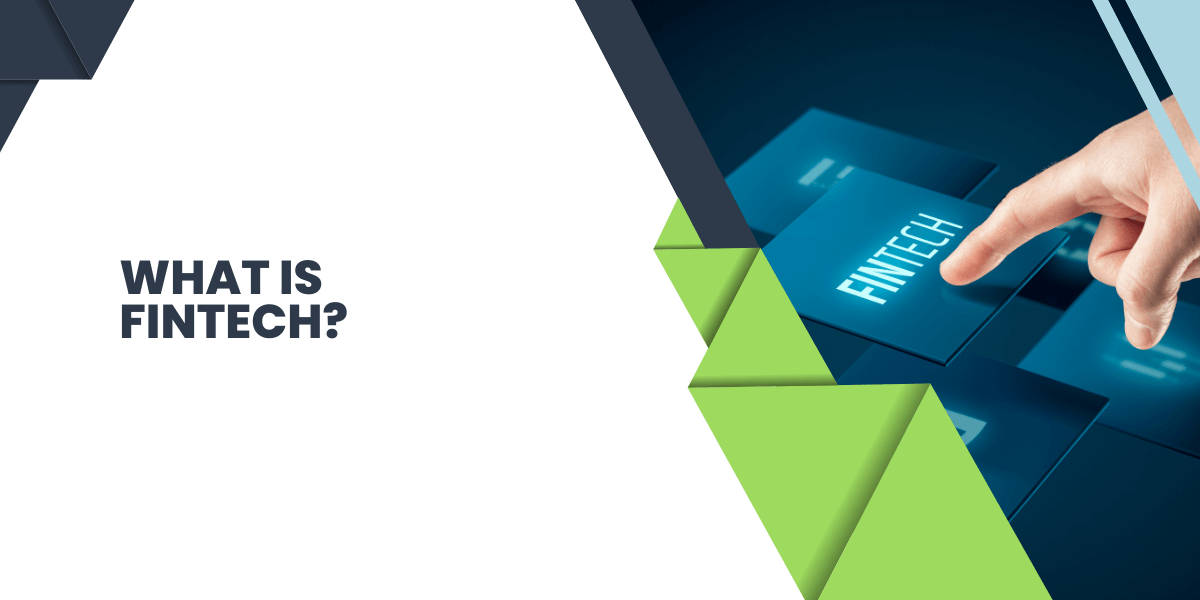
The term “fintech” refers to the digitalization of the financial sector. It includes using cutting-edge technology and fresh ideas to make banking easier for more people. Fintech uses AI, blockchain, data analytics, and mobile technology innovations to alter the face of banking, investing, and money transfers.
Fintech works to increase access to financial services, efficiency in business operations, the quality of services provided to customers, and the rate of technological advancement in the financial sector by doing away with outdated methods and replacing them with digital ones.
What Is A SaaS Fintech Product?
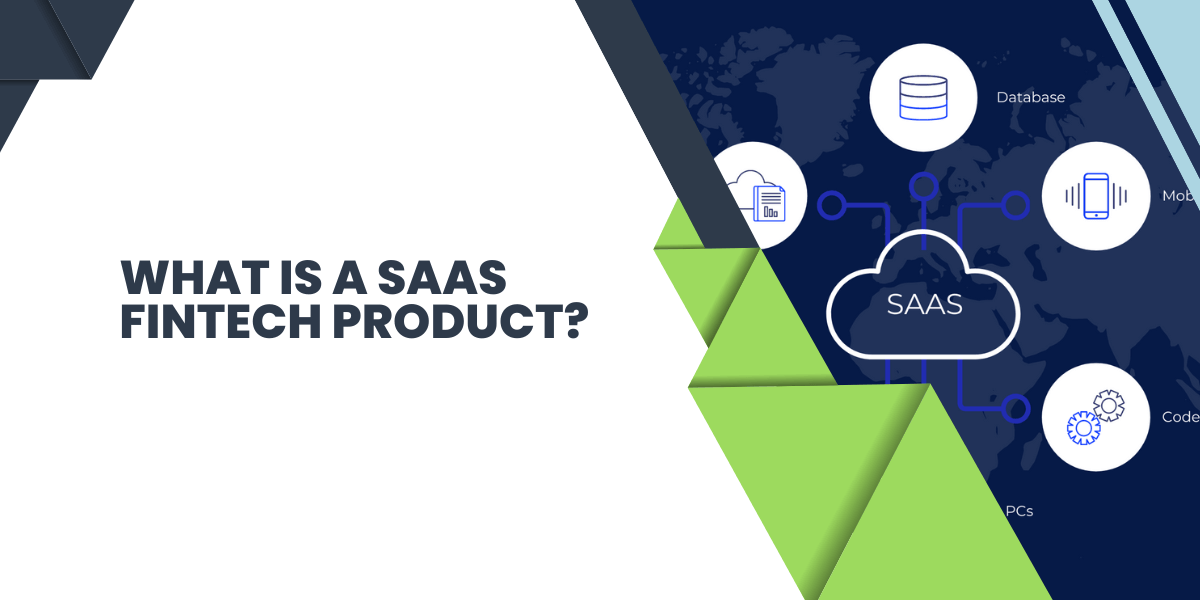
Software as a service, or SaaS, financial solutions can be accessed and utilized entirely online. Financial institutions, entrepreneurs, and service providers may use this approach to give their clients access to recurring financial services.
These digital financial solutions, such as online banking platforms and digital payment systems, are often developed by firms specializing in fintech. These items are based on the Software-as-a-Service (SaaS) model, which allows consumers to access the product through a web browser or mobile app and stores all data in the cloud. The capacity to scale, adapt, and reduce costs while still providing cutting-edge financial solutions to customers is a major benefit of this method.
What Are Different Types Of SaaS Fintech Applications?
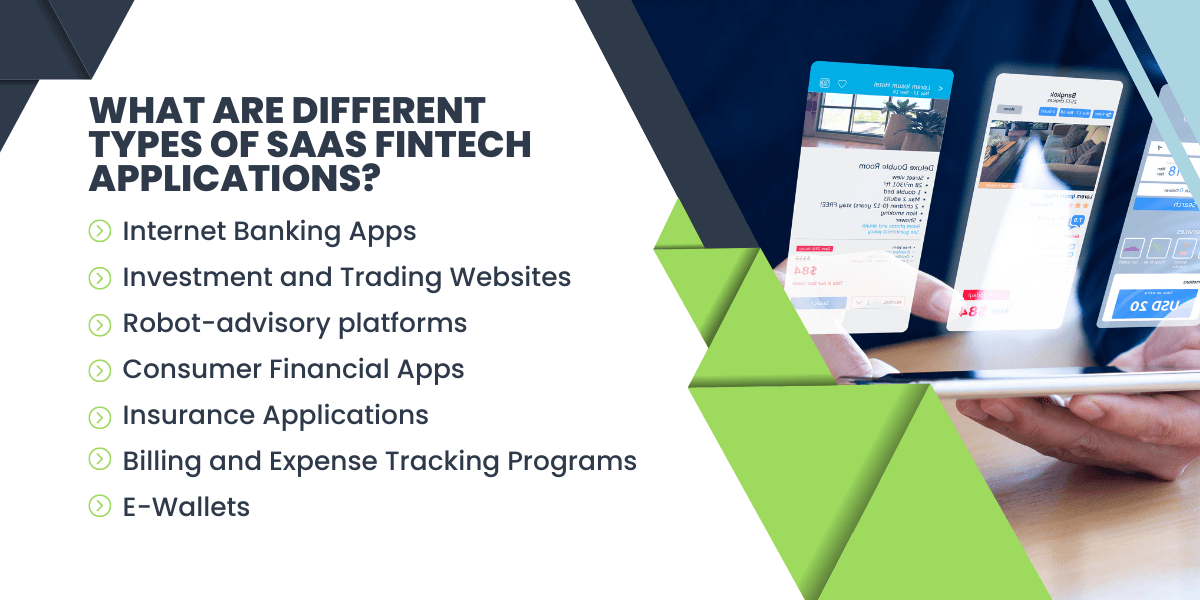
Many software as a service (SaaS) fintech apps facilitate financial transactions. There are many prospects and viable company concepts in the enormous financial sector. Investors in fintech businesses expect a significant return on their initial capital investment. Some examples of finance SaaS applications are as follows:
Internet Banking Apps
SaaS internet banking software has completely altered the way individuals handle their money. Apps like Acorns, Current, Chime, and Ally Mobile make Internet banking more accessible. The need to physically visit a bank branch to create an account, make a payment, or monitor one’s affairs is eliminated. By allowing users to meet their regulatory obligations from the convenience of their mobile devices, internet banking applications have increased the availability and efficiency of financial transactions.
Investment and Trading Websites
Due to the application of SaaS in Fintech, access to the financial markets has been widened in the trading and investing industry. Individuals may engage in stock trading platforms, FX trading, and capital markets via platforms such as Robinhood, Webull, Cash App, Firstrade, and E-trade. Online trading may be a great way for investors of all skill levels to make money, and these apps make it simpler than ever to create, manage, and trade assets.
Robot-advisory platforms
Using SaaS technology, robo-advisory platforms provide automated financial advice and portfolio management. Betterment, Wealthfront, and SigFig are just a few examples of these sites that employ data analysis and algorithms to tailor investment suggestions to each user’s unique situation and interests. With the SaaS model’s scalability and low overhead, expert financial advice may be available to a wider audience.
Consumer Financial Apps
Money management is made easier with the help of consumer finance apps. Financial management functions, including budgeting, cost monitoring, goal planning, and savings management, are all available in mobile applications. Mint, Personal Capital, and PocketGuard are examples of consumer financial applications. These programs provide people with the tools they need to manage their own money to set and achieve realistic financial objectives.
Insurance Applications
Insurance companies and their policyholders may both benefit from using SaaS fintech technologies. These programs may function as customized customer relationship management systems for insurance companies, facilitating the administration of policies, claims, and individual client data. Insurance apps allow policyholders to see coverage details, file claims, and connect with customer care representatives online. Lemonade, Policybazaar, and Oscar are a few examples of insurance applications.
Billing and Expense Tracking Programs
Cloud-based invoicing and cost-tracking solutions help organizations save time and money. Invoices, receipts, and expenditure reports are all easier to keep tabs on and handle with the help of software like Expensify, QuickBooks, and FreshBooks. They include tools like sorting expenses by category, scanning receipts, generating reports, and connecting to accounting software. The SaaS approach facilitates accurate and streamlined reimbursement procedures, allowing firms to manage their financial records better.
E-Wallets
One prominent instance of financial digitalization is the rise of digital wallets. They facilitate online payments by enabling users to keep their money in a digital wallet. Apple Pay, Paytm, and Google Pay (GPay) are only some of the most widely used examples of digital wallets. Whether for online purchases, peer-to-peer fund transfers, or contactless payments in shops, these applications safely store users’ payment information and provide smooth transactions.
Top 10 Examples Of Fintech SaaS Applications
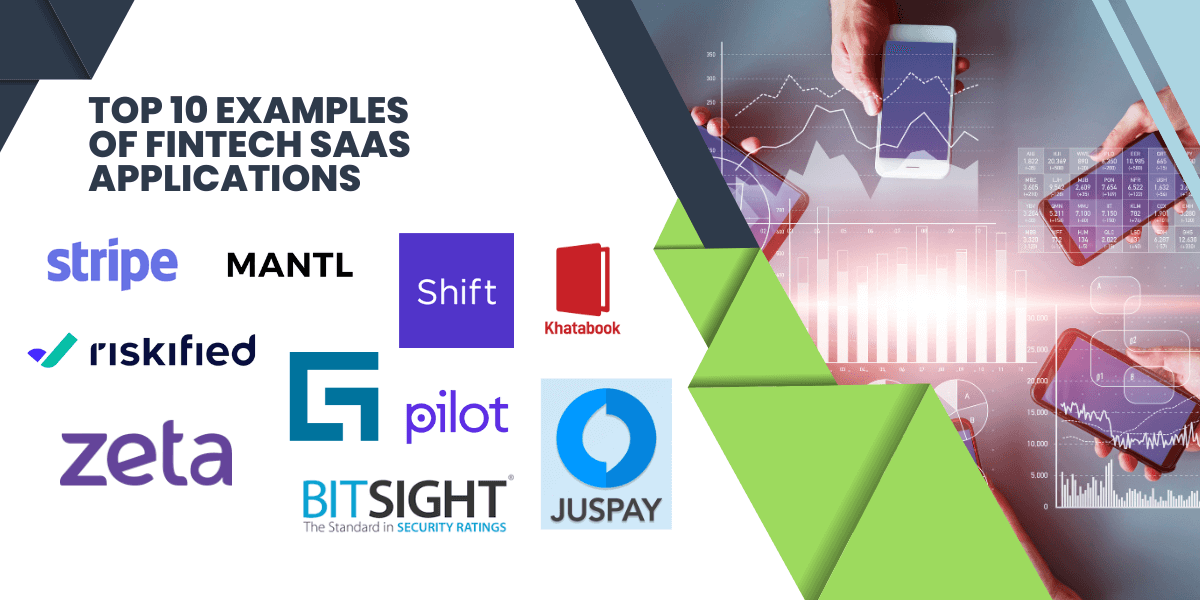
Stripe
Stripe is a prominent example of a fintech SaaS offering various services, such as international payments, banking services, revenue optimization, and financial automation. It paves the way for companies all around the globe to take payments online.
Shift Technology
To combat insurance fraud and streamline the claims process, Shift Technology provides AI-native to businesses. Their AI-powered technology allows for reliable and accurate insurance choices.
MANTL
Customers may quickly and easily establish deposit accounts from any mobile device thanks to the MANTL SaaS enterprise business model. Many companies’ first funding campaigns were only possible with their technology.
ZETA
Zeta provides companies and banks with cloud-based payment and banking solutions. Payments to employees, customers, and suppliers may all be handled on their platform.
Riskified
Riskified is an artificial intelligence (AI)-based platform that protects businesses against online payment fraud. Machine learning algorithms and big data analytics glean payment insights for accepting or rejecting transactions.
GuideWire
GuideWire offers insurance policy administration services in the cloud and using AI. Products provide a wide range of insurance industry needs, from claims processing, invoicing, underwriting, policy administration, sales, and predictive risk analysis.
Pilot.com
Pilot.com provides bookkeeping and CFO consulting services. Their software simplifies Financial management, offering expert advice and guidance in this area.
JusPay
JusPay is an all-inclusive platform that provides payment services from start to finish. It supports various payment types via its payment gateways, UPI full-stack solutions, and unified payout options.
BitSight
BitSight is a financial technology software as a service (fintech SaaS) program built specifically for managing cyber risk. Services, retail, healthcare, manufacturing, and academia are some of the industries that might benefit from the company’s financial management services.
The variety and depth of fintech SaaS solutions on the market are shown by these top 10 examples. These solutions, which range from fraud detection to budgeting, illustrate how technology is revolutionizing and improving financial procedures in various settings.
Key Features Of Fintech Saas Products
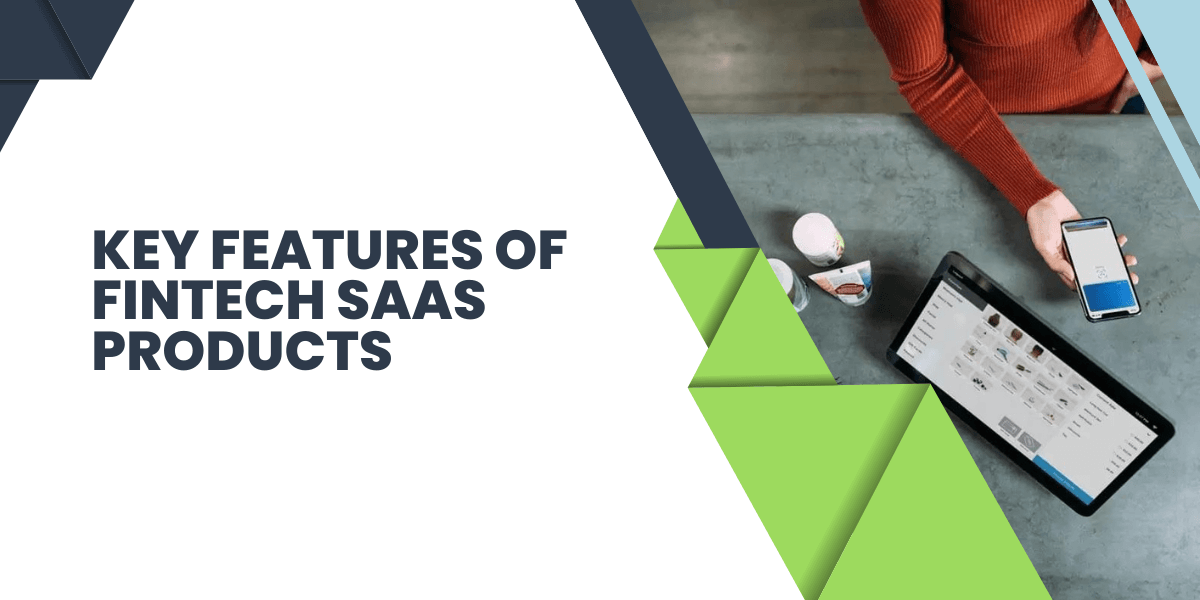
User-Friendly Design
It is essential for financial technology software as a service app to have a clean and intuitive user experience. The user experience must be smooth and straightforward. Your app’s ability to stand out from the crowd and win over new users depends on how effectively its interface is built.
Gateway for making payments
Fintech applications can’t function without a safe and secure payment processor. Money transfers, digital payments, and checking account balances are all fundamental financial tasks that users should be able to do without any hassle. Achieving user trust requires striking a balance between ease of use and safety.
Safety
Safety is of utmost importance in financial technology SaaS offerings. Users entrust their personal banking information, making it imperative to take data security very seriously. Protect user information by using strong authentication methods, encryption, and keeping up with security best practices.
Customized Interaction
User engagement and happiness may be increased by providing a tailored experience. Make it possible for users to choose their preferences inside the app, get personalized alerts, and filter content.
Managing Customers
Include user management tools if your program is meant for households or companies with many users. Facilitate teamwork and account management by allowing multiple users access to the app.
Online chats
The user experience and quality of customer service may benefit from using online chat or AI-powered chatbots. Users may have their questions answered and problems solved faster via chat than they would through phone or email.
Bank Account Linking
Users may access their bank accounts and do all necessary banking functions without leaving the app. Provide a full suite of financial management tools, including account balance viewing, transaction history, and money transfer creation.
Plug-in extensions
It would help to consider including external tools and features in your financial app. This has the potential to bring new features and benefits to its consumers. For instance, a more complete and easy experience may be provided by integrating services like meal ordering or financial management applications.
Steps to Build a SaaS Fintech Product
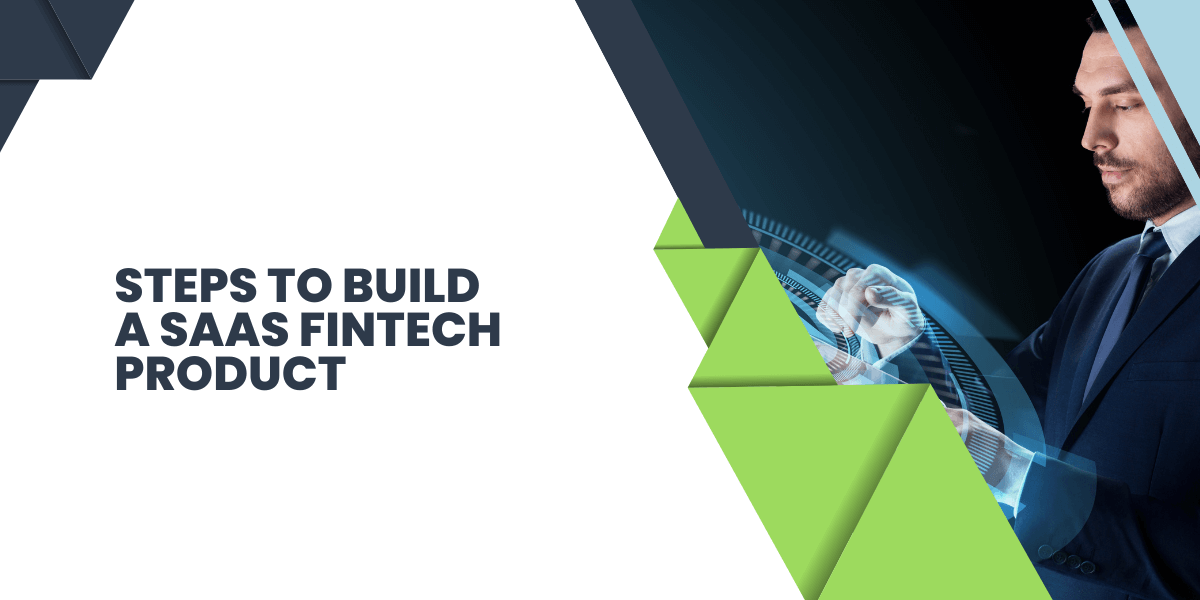
Being a leading mobile app development company, we are building Fintech Saas applications. Look at the features we offer-
Step 1: Study And Research The App And The Market
Start by learning as much as possible about the specific financial program or app you want to create. Find out whether it will target a niche market or be more accessible to a wide range of professionals. You may better comprehend the market and user requirements by analyzing your intended audience, final consumer, and project scope in-depth.
Step 2: Choice Of The Technology Stack
Make sure your financial technology SaaS offering uses the right stack of technologies. Think about using a front-end framework like Angular or a back-end one like Java, Python, or Node.js. In JS and React Native. Choose the right databases, hosting services (like AWS), and integration tools (like Stripe, PayPal, and the Plaid and Twilio APIs) to meet your needs. Make sure the technology you use fits the needs of your project.
Step 3: Recruit A Dedicated Group
Gather an expert and committed crew to work on your financial technology venture. You’ll need front-end and back-end programmers, project managers and DevOps specialists. Your fintech application’s complexity and breadth will determine the optimal team size. You may build a team of experts in-house or choose a reputable SaaS development firm to take on the job.
Step 4: Make A Model And A Workflow
Build a mockup of your financial app’s user interface and main features to understand its potential success better. Create a detailed mental picture of the app’s features and how they work together with the help of drawings or digital tools.
Step 5: Interaction And User Experience Design
When the prototype is complete, you can focus on creating a beautiful and functional user interface and user experience. The design has to be consistent and straightforward so that users can easily navigate the app’s functionality. Positive user experiences result from many elements, including appealing graphics and straightforward navigation.
Step 6: Create And Test An MVP
Creating an MVP is essential for validating the basic functionality of your financial product and collecting user feedback. Construct a minimal executable that displays the app’s primary features. Use iterative testing and user input to improve the MVP’s performance, features, and usability.
Step 7: Launch And Updates
When you are satisfied with your finance SaaS product after the creation and testing stages, it is time to release it to the public through the appropriate distribution channels. Make sure you’re following all applicable safety rules and norms. Fix issues, optimize efficiency, and expand functionality with regular updates that consider user comments and market needs.
Maintain a focus on security and meeting applicable financial rules throughout development. Work together with banks and other service providers to get your payments system set up and running smoothly. Building and sustaining a successful finance SaaS solution requires a focus on the consumer and a dedication to constant development.
Conclusion
The fintech business has grown exponentially in recent years, altering how consumers interact with financial institutions and products. SaaS apps in the financial technology industry are paving the way in this new digital era by delivering quick and easy answers to a wide range of problems in the financial sector.
If you want to build a Fintech Saas product, connect with Echoinnovate IT- the leading software development company. We have experience developing quality fintech applications for global clients. Contact us now for a free consultation or get a quote.
FAQs
What Is A Fintech SaaS Product?
Fintech SaaS products integrate financial technology with cloud-based services to make banking more convenient and accessible for consumers and enterprises.
Can I Customize The Fintech SaaS Product To Fit My Specific Business Needs?
The degree to which a fintech SaaS solution may be tailored to a business’s unique needs varies from vendor to vendor. While some vendors may allow you to modify their products to meet your company’s specific requirements, others may have fewer possibilities or demand more development time.
How Does Data Security And Privacy Work With The Fintech SaaS Product?
Fintech SaaS products often include stringent security measures, including encryption, access restrictions, and frequent security audits to safeguard the safety and privacy of their customer’s data. Service providers follow rigorous compliance criteria to keep customers’ personal information safe and secure.
What Kind Of Integrations Are Available With Other Software Or Systems We Use?
Integrations with other business-centric applications are a key feature of fintech SaaS packages. Accounting programs, payment processors, customer relationship management platforms, banking application programming interfaces, and similar programs may all be integrated to facilitate smooth data transfer and streamline business processes.
